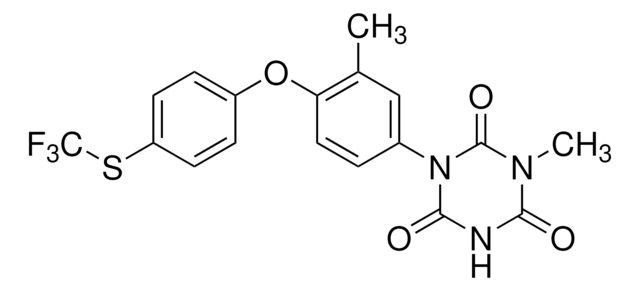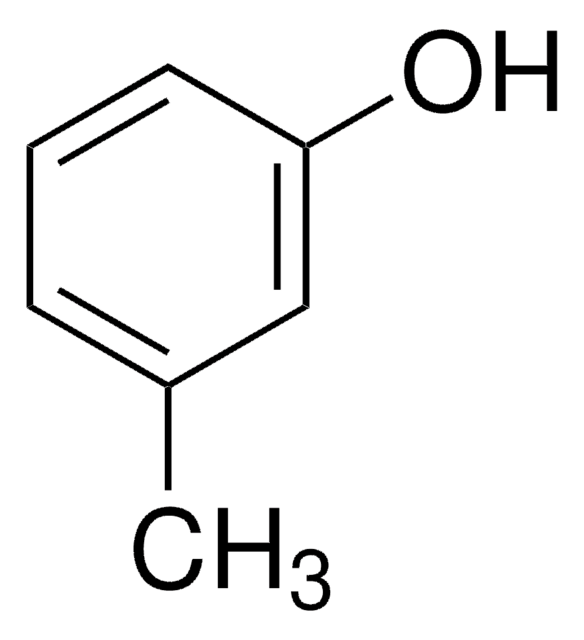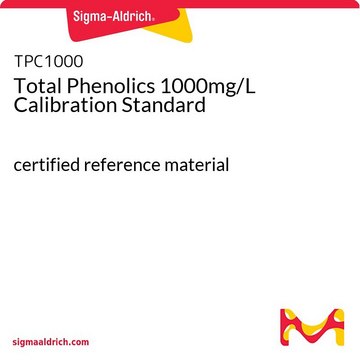Wichtige Dokumente
35952
Phenol
PESTANAL®, analytical standard
Synonym(e):
‘Carbolsäure’
About This Item
Empfohlene Produkte
Qualität
analytical standard
Qualitätsniveau
Dampfdichte
3.24 (vs air)
Dampfdruck
0.09 psi ( 55 °C)
0.36 mmHg ( 20 °C)
Produktlinie
PESTANAL®
Selbstzündungstemp.
1319 °F
Haltbarkeit
limited shelf life, expiry date on the label
Expl.-Gr.
8.6 %
Methode(n)
HPLC: suitable
gas chromatography (GC): suitable
bp
182 °C (lit.)
mp (Schmelzpunkt)
40-42 °C (lit.)
Dichte
1.071 g/mL at 25 °C (lit.)
Anwendung(en)
agriculture
cleaning products
cosmetics
environmental
flavors and fragrances
food and beverages
personal care
Format
neat
SMILES String
Oc1ccccc1
InChI
1S/C6H6O/c7-6-4-2-1-3-5-6/h1-5,7H
InChIKey
ISWSIDIOOBJBQZ-UHFFFAOYSA-N
Suchen Sie nach ähnlichen Produkten? Aufrufen Leitfaden zum Produktvergleich
Allgemeine Beschreibung
Anwendung
Empfohlene Produkte
Rechtliche Hinweise
Sie haben nicht das passende Produkt gefunden?
Probieren Sie unser Produkt-Auswahlhilfe. aus.
Ähnliches Produkt
Signalwort
Danger
Gefahreneinstufungen
Acute Tox. 3 Dermal - Acute Tox. 3 Inhalation - Acute Tox. 3 Oral - Aquatic Chronic 2 - Eye Dam. 1 - Muta. 2 - Skin Corr. 1B - STOT RE 2
Zielorgane
Nervous system,Kidney,Liver,Skin
Lagerklassenschlüssel
6.1A - Combustible acute toxic Cat. 1 and 2 / very toxic hazardous materials
WGK
WGK 2
Flammpunkt (°F)
177.8 °F - closed cup
Flammpunkt (°C)
81 °C - closed cup
Persönliche Schutzausrüstung
Eyeshields, Faceshields, Gloves, type P2 (EN 143) respirator cartridges, type P3 (EN 143) respirator cartridges
Hier finden Sie alle aktuellen Versionen:
Besitzen Sie dieses Produkt bereits?
In der Dokumentenbibliothek finden Sie die Dokumentation zu den Produkten, die Sie kürzlich erworben haben.
Kunden haben sich ebenfalls angesehen
Artikel
Separation of 2-Chlorophenol; 2,4-Dichlorophenol; 2,4,6-Tribromophenol; 2,4,6-Trichlorophenol; 2,4-Dinitrophenol; Pentafluorophenol; 2-Methylphenol, analytical standard; 2,3,4,6-Tetrachlorophenol; Pentachlorophenol; 4-Nitrophenol; 2-Bromophenol; 2,3,5,6-Tetrachlorophenol; 2,3,5-Trichlorophenol; 4-Chloro-3-methylphenol; 2,4,5-Trichlorophenol; 4-Methylphenol, analytical standard; 2,4-Dimethylphenol; 2-Nitrophenol; 3-Methylphenol, analytical standard; Phenol; 2-Methyl-4,6-dinitrophenol; 2,3,4-Trichlorophenol; 2,6-Dichlorophenol; 2,3,4,5-Tetrachlorophenol
Protokolle
Separation of 2-Nitrophenol; Pentachlorophenol; 2-Bromophenol; Phenol; 4-Nitrophenol; 3-Methylphenol, analytical standard; 4-Chloro-3-methylphenol; 2,4-Dichlorophenol; 2,3,4,6-Tetrachlorophenol; 2-Methylphenol, analytical standard; 2,4,6-Trichlorophenol; 2,4-Dimethylphenol; 2-Chlorophenol
HPLC Analysis of Cresols and Phenol on Astec® CYCLOBOND® I 2000
HPLC Analysis of Phenols on SUPELCOSIL™ LC-8
Unser Team von Wissenschaftlern verfügt über Erfahrung in allen Forschungsbereichen einschließlich Life Science, Materialwissenschaften, chemischer Synthese, Chromatographie, Analytik und vielen mehr..
Setzen Sie sich mit dem technischen Dienst in Verbindung.








